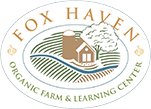News: Alive & Awake – Early Spring Greens Chase Away Winter Blues
Truthfully, I am not a morning person. On cold, gray days I growl like a bear roused from hibernation when the alarm clock sounds. Early spring is different. The sun finally shows its face again and I feel a surge of joy for new beginnings. The sensation of crisp air and warm sun on pallid skin, the sight of delicate green shoots emerging, is a wondrous wake-up call. The world is fresh and new.
Victoria Greba’s “The Green Things” class at Fox Haven Farm on March 11 was especially energizing. The class description invites participants to “take a deeper look at what green things are popping up or still hiding beneath the ground, and become gatherers of these ancient foods which can nourish our bodies, hearts, and minds in the same way they have nourished mankind for all of mankind’s time upon the Earth.”
Soft-spoken and gently encouraging, Victoria’s deep regard for nature and our place in it is immediately evident. After brief introductions, we trot to the over-wintered garden below the big red barn. What looks like a simple “lawn” is, in fact, a veritable smorgasbord of nourishing edibles. We collect mounds of chickweed (more vitamin C, calcium and iron than spinach) and tender dandelion greens, roots, and blossoms (known for potassium and support of liver function). We get to know Creeping Charlie and pungent Garlic-Mustard, Henbit, with its tiny fuchsia flowers, purple-tinged clumps of Dead Nettle, and wild turnips…all growing raucous and free.
The youngest member of our group is with her mother. She finds the largest “turnip” of the day. It’s a gnarled, white taproot the size of a hand. Once our eyes attune to the quarry, it seems like most of the landscape is edible.
A smile creeps across Victoria’s face in response to our enthusiasm, but she cautions, “Don’t ever eat a plant unless you are 100% sure of what it is.” As reference, she continued, “You should be as confident (eating a wild a plant) as picking out veggies from the supermarket.” Testing edibility by tasting is highly discouraged. “There is a lot of poison Hemlock in Maryland.” When in doubt, leave it be.
Sometimes a picture is the best “harvest” of the day. Most newbies (like me) stick to cross-referencing several guidebooks or joining expert-led forage forays. Victoria suggests a few books for starters, including the Reader’s Digest North American Wildlife: An Illustrated Guide to 2,000 Plants and Animals and Foraging and feasting with Dina Falconi. Online, YouTube’s Dean Green “Eat the Weeds” channel and Plants For A Future (PFAF.org) are good resources, too. Working with a variety of teachers can round out your information, because each person has a unique perspective and experience to share.
“Go slow,” says Victoria. “Start a nature journal and go to the same spot during different seasons” to understand different stages of growth. (Fox Haven’s Food, Medicine, and Art Foragers series – A Journey Through the Seasons in 2017 – offers that opportunity.)
She assures us that we don’t have to learn everything at once. Adding one or two new edibles a year to a foraging repertoire can be enough. “There is such a richness in nature,” she reflects, “We have narrowed the number of foods we eat.” Foraging can fill in the gaps with “chlorophyll-, mineral-, and vitamin-rich tender greens to quench the body’s need for fresh nutrition.”
Leaving the garden, we wander down the gravel lane, collecting daylily shoots from abundant patches a few meters into the woods. Their tangled clusters of thumbnail-sized bulbs look like mini potatoes when scrubbed. These are gifts of beauty and sustenance, as all parts of the plant are edible, in moderation, throughout the year – starchy roots, pale inner leaves, and spicy orange flowers. FYI, not all lilies are edible.
Steps away we find frilly sprouts of stinging nettle. Some brave souls gingerly touch the spiny leaves to understand its sensation. (Ouch!) Others pluck sprigs with gloved hands or use friendlier leaves as a buffer. Once cooked, the nettle loses its sting. Like dandelion, it is hailed as a particularly restorative tea. Both greens can be sautéed as a side dish.
Back in the Chestnut House kitchen, many hands make light work of processing our harvest. Dandelion greens and blossoms are steeped. Roots are cleaned and peeled before cooking. Diminutive daylily “potatoes” are boiled until tender. Even the nettles become tame after a quick sauté with olive oil and salt. The chickweed is simply dressed in Victoria’s home-made vinegar to accent its mild corn-like flavor. Fresh baked bread, blueberries and tangerines augment our found feast. And, judging by empty bowls, wild turnips bathed in European-style butter, reminiscent of nutty parsnips, are the hit of the day, along with the surprisingly mild nettles.
Victoria’s final words of encouragement remind us that learning and awareness continue outside of class time. “The first place to forage is right outside your stoop. It seems odd to me to drive miles to collect greens. You must start as stewards to your own land.” The words give me new appreciation for the healthy crop of dandelions and chickweed surrounding my home.
As we leave she nods gracefully, bidding us, “Joy on your journey.” Indeed. Joy is nourishment, too, if you know where to look.
